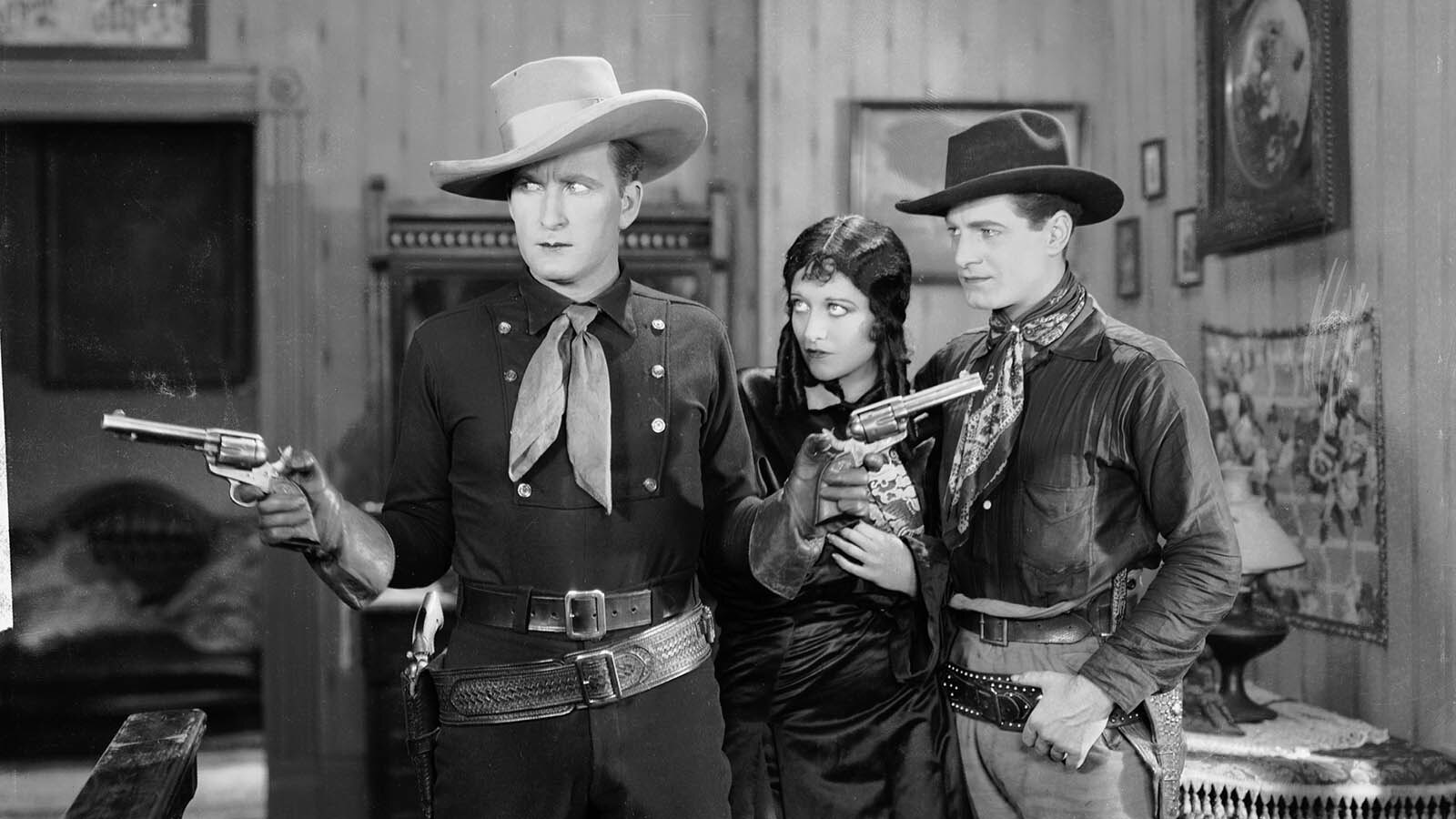In the early days of film, Wyoming native Tim McCoy was one of the “Big Four” Hollywood Western stars alongside Tom Mix, Ken Maynard and Hoot Gibson.
During his career, beginning in the 1920s, McCoy appeared in nearly 100 films and was one of the few who made the transition from silent films to talkies with ease, thanks to his golden voice.
In later years, McCoy had his own popular children’s television show in Los Angeles, won an Emmy and a star on the Hollywood Walk of Fame. His second wife was Inga Arvad, a Danish journalist and screenwriter who Adolf Hitler infamously referred to as the “Nordic beauty.”
Although he was once a Hollywood darling and a hero to thousands of American children, many people today have never heard of McCoy, who rose to prominence even ahead of a young film actor named John Wayne who was just starting his career. McCoy was announced as the star of the 1932 film “Texas Cyclone,” and the young Wayne was listed in the opening credits among “The Players.”
Not only was McCoy rugged and handsome like a leading man, but he was also easily recognizable in many of his westerns by his characteristic large cowboy hat.
McCoy was mentored in his early years by former outlaws who worked with him in the mountains of Wyoming. He later owned a ranch, the Eagles Nest, in the foothills of the Owl Creek Mountains in Hot Springs County. He was also a recognized authority on Western Indian affairs and a military officer.
The Wyoming Runaway
McCoy grew up in Michigan as the son of Irish immigrants and read all the dime novels about adventures in the Wild West.
According to McCoy’s autobiography, Tim McCoy Remembers the West, his first exposure to cowboy life was at age seven at one of Buffalo Bill’s Wild West shows in Saginaw, Michigan. He met the famous Buffalo Bill Cody backstage and was speechless with awe.
Later, as a young man, he spent time at the railroad yard, where wild horses were sold and the main attraction was cowboys taming them.
A cowboy, McCoy recalls, didn’t know how to catch a semi-wild bronco until Bob taught him. After that, young McCoy was determined to become part of this exciting life.
In 1909, McCoy wrote that at age 18, he left the Jesuit school he was attending and, without telling his parents, rode off into the western sunset to become a cowboy – although he had no idea where to hang his hat. Oklahoma? Nebraska? Montana? Arizona?
In a chance encounter on the train ride west, he met a bronco rider from Lander who persuaded McCoy to come to Wyoming.
His first job as a cowboy was with the Double Diamond Cowboy Band on the Wind River outside of Lander. For eight years, McCoy rode through the Wyoming countryside to round up herds of cattle and sing to the cattle on the prairie.
Like many young cowboys of that time, he worked on several ranches and moved on when the pace became too monotonous and he needed a new adventure.
During this time, McCoy encountered legends of the Wild West around campfires, where former outlaws told stories of their adventures from long ago. On his days off, he often rode to Cody and spent many hours at the Irma Hotel listening to Buffalo Bill Cody tell his stories.
Supervised by outlaws
In 1910, McCoy rode into Thermopolis, where the streets were dirt and all but one building was made of wood. He explored the young town’s saloons and, after being assessed by the local law, was accepted as a regular cowboy looking for work.
McCoy recalls that after the sheriff concluded that he was not a “bad guy,” he referred him to Irishman Tom Walsh.
McCoy joined Irish Tom’s Outlaw Train, which was notorious for rounding up all the stray cattle in the area, despite the Maverick Law banning the practice of branding other men’s cows. It also made an impression on young cowboys who tried to build up their own herds this way.
McCoy openly admitted that during his years in Thermopolis, many acquaintances and friends had been found shot in the back for rounding up other men’s cattle, or had simply been accused of doing so.
McCoy’s first partners included Henry Rothwell, an upright college graduate who introduced the young cowboy to Thermopolis’s upper class, and Frank James, one of the former outlaws.
James was a known member of the Hole-in-the-Wall Gang, the notorious band of outlaws who committed robberies in and around Hole-In-the-Wall Pass. He was also the cousin of the James Brothers, according to his grandson Bob James in a 2022 interview.
The young McCoy was fascinated by the story. He met the heroes and villains from the pulp novels of his youth.
Singing Cowboy
McCoy wrote that when he was still a cowboy for Irish Tom, he got his nickname from his golden voice. Two-man guard teams worked through the night, one riding clockwise, the other anti-clockwise, to keep the cattle together. Thus was born the legend of the singing cowboy.
It didn’t take much to frighten the half-wild cattle. If a man stopped to light a cigarette, the flash of the match was enough to send the cattle running. The clink of spurs or any other noise could also send them running.
To calm the cattle, the cowboys sang as they rode in a night circle. The cattle became accustomed to their voices and popular tunes included “Chisholm Trail” and “Sam Bass.”
McCoy had a beautiful tenor voice and sang the soft, lilting music of his Irish childhood instead of the usual Texas songs. When he was up early, the other cowboys would lie awake and listen to him singing under the starry sky of Wyoming.
In his memoirs, McCoy recalls that one evening he was sitting around the fire eating dinner and someone asked who the second watchman was. Irish Tom replied, “Ted Price and the canary.”
McCoy protested, “Wait a minute – I’m on guard with Ted Price!”
Frank James, still a half-outlaw, replied, “Haven’t you heard your name, young fellow? You’re the Irish Tom’s Canary.”
The name stuck and followed McCoy as he moved from ranch to ranch.
On the way to Hollywood
After leaving the Outlaw Train, McCoy established his own ranch in the Big Horn Basin, through which the Owl Creeks flow.
He had briefly left Wyoming to join the Army, and while at Fort Snelling he had married a Jackson Hole equestrian named Agnes Miller. The couple returned to Wyoming to raise their three children.
During World War I, he sent a telegram to then-President Teddy Roosevelt suggesting that he recruit cowboys for the cavalry. He received a response telling him to go ahead.
Although the cavalry was disbanded before these enthusiastic young men could go into battle, McCoy’s time as a soldier helped him rise to the rank of Adjunct General for Wyoming.
It was now 1922 and McCoy had been Adjutant General of Wyoming for almost three years. By the age of 31, his ranch on the North Fork of Owl Creek had been expanded to 2,500 acres, and another 2,500 acres had been leased from the government. At this time, McCoy kept a herd of 350 cattle, had a wife and three children.
But McCoy was bored.
That was the moment when Hollywood knocked on the door.
An epic silent film called “The Covered Wagon” was produced, which required 500 Native Americans as extras.
Over the years, McCoy had made several lifelong friends among the Arapaho Indians and learned plains sign language. McCoy wrote that he was asked to provide care for these men, and that is exactly what he did, along with Lander pioneer Ed Farlow.
According to Farlow’s memoir, “Wind River Adventures: My Life in Frontier Wyoming,” they brought members of several tribes together for the film.
Even before The Covered Wagon premiered in early 1923, McCoy was already receiving offers to star in his own films. Although his first film, The Dude Wrangler, a project that was to have been shot in Thermopolis, was abandoned, McCoy went on to star in nearly 100 films in Hollywood.
In 1931, he and his wife Alice divorced. She raised their three children on the Eagles Nest Ranch while McCoy commuted between Wyoming and Hollywood. McCoy kept half of the ranch before marrying a Danish beauty with a fascinating past: Inga Arvad.
The two eventually moved to another house in Pennsylvania. There, in a mansion designed by McCoy, Arvad raised their two sons while McCoy was away 360 days a year caring for his second family.
Despite all his fame, when McCoy sat down to write his memoirs with his son Ronnie, it was not about his years in Hollywood, but about his time as a young cowboy in Wyoming.
McCoy often said that despite the glitz and glamour of Hollywood and his role as a great Western film star, his heart belonged to Wyoming.
Contact Jackie Dorothy at [email protected]
Jackie Dorothy can be reached at [email protected].









